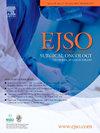胸段食管鳞状细胞癌患者新辅助免疫化疗后食管切除术后复发的模式。
IF 2.9
2区 医学
Q2 ONCOLOGY
引用次数: 0
摘要
目的:探讨食管切除术后新辅助免疫化疗(NICT)患者胸段食管鳞状细胞癌(TESCC)复发模式及相关危险因素。方法:回顾性分析2019 - 2022年NICT术后行食管切除术的191例TESCC患者。评估第一次复发模式。术后无复发生存(RFS)采用Kaplan-Meier法测定。采用logistic回归模型进行多因素复发危险因素分析。结果:截至2023年12月31日随访,66例患者出现复发,中位复发时间为10.8个月(1.2-37.3个月)。复发类型包括局部复发(LR)、远处复发(DR)和LR + DR,分别占69.7%、16.7%和13.6%。局部区域淋巴结(LN)是术后复发的主要形式(40/66),特别是在纵隔站2R(17.5%)和4R(16.5%)。淋巴结清扫点≤6、7-9、10-14组的2年RFS分别为50.5%、72.3%、63.5% (P = 0.04)。同样,淋巴结清扫5 cm组的2年RFS率、t分期评价为临床稳定、淋巴结清扫点数≤6、ypN2-3分期均为患者术后失败的不利因素。结论:在TESCC患者中,NICT后LN复发可能是主要的LR模式,特别是在2R和4R站。此外,不建议小于6个淋巴结清扫站或小于15个淋巴结清扫站。本文章由计算机程序翻译,如有差异,请以英文原文为准。
Patterns of recurrence after esophagectomy following neoadjuvant immunochemotherapy in patients with thoracic esophageal squamous cell carcinoma
Purpose
To explore the recurrence pattern and risk factors associated with the relapse of thoracic esophageal squamous cell carcinoma (TESCC) among patients who received esophagectomy following neoadjuvant immunochemotherapy (NICT).
Methods
A total of 191 TESCC patients who received esophagectomy following NICT were retrospectively reviewed from 2019 to 2022. The first recurrence patterns were assessed. The postoperative recurrence-free survival (RFS) was determined using the Kaplan–Meier method. Multivariate recurrence risk factor analysis was performed using the logistic regression model.
Results
As of the December 31, 2023 follow-up, 66 patients experienced recurrence, with a median time to recurrence of 10.8 months (1.2–37.3 months). The recurrence pattern included locoregional recurrence (LR), distant recurrence (DR), and LR + DR, accounting for 69.7 %, 16.7 %, and 13.6 %, respectively. Locoregional lymph node (LN) predominated the pattern of postoperative recurrence (40/66), particularly in the mediastinal station 2R (17.5 %) and 4R (16.5 %). The 2-year RFS rates for groups with dissected LN stations of ≤6, 7–9, and 10–14 were 50.5 %, 72.3 %, and 63.5 %, respectively (P = 0.04). Similarly, the 2-year RFS rates for groups with dissected LNs of <15, 15–29, and ≥30 were 49.7 %, 61.6 %, and 71.6 %, respectively (P = 0.28). Furthermore, tumor length >5 cm, the T-stage evaluation as clinically stable disease, dissected LN stations ≤6, and the ypN2–3 stage were unfavorable factors for postoperative failure in patients.
Conclusions
The major pattern of LR may be LN recurrence after NICT in TESCC patients, particularly in the station 2R and 4R. In addition, less than 6 LN dissection stations or less than 15 LNs are not recommended.
求助全文
通过发布文献求助,成功后即可免费获取论文全文。
去求助
来源期刊

Ejso
医学-外科
CiteScore
6.40
自引率
2.60%
发文量
1148
审稿时长
41 days
期刊介绍:
JSO - European Journal of Surgical Oncology ("the Journal of Cancer Surgery") is the Official Journal of the European Society of Surgical Oncology and BASO ~ the Association for Cancer Surgery.
The EJSO aims to advance surgical oncology research and practice through the publication of original research articles, review articles, editorials, debates and correspondence.
 求助内容:
求助内容: 应助结果提醒方式:
应助结果提醒方式:


